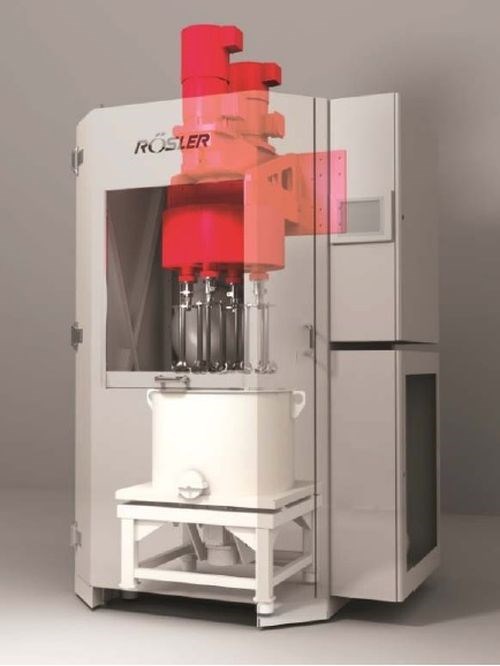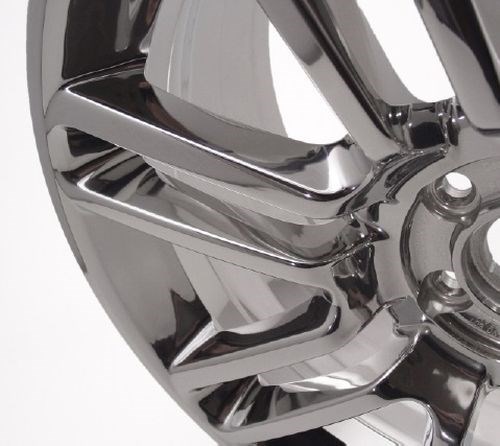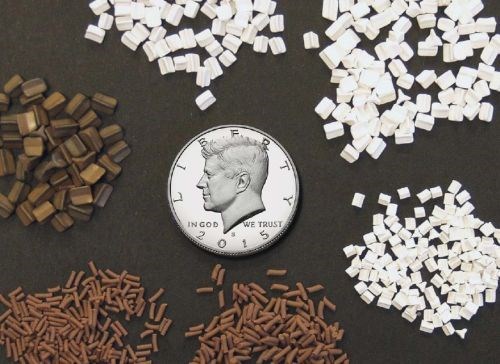Latest Developments in Mass Finishing
New materials, manufacturing processes, automation and the need for better surface finishes have driven new developments in mass finishing. This article discusses finishing solutions for very large and heavy parts, explains drag finishing technology, introduces surf finishing technology and showcases two new media developments.
#research #surfin
by
Bernhard Kerschbaum
Featured Content
Rosler Metal Finishing USA, L.L.C.
Battle Creek, MI, USA
Editor’s Note: This paper is a peer-reviewed and edited version of a presentation delivered at NASF SUR/FIN 2016 in Las Vegas, Nevada on June 6, 2016. A printable PDF version is available by clicking HERE.
ABSTRACT
New materials, manufacturing processes, automation and the need for better surface finishes have driven new developments in mass finishing. This article discusses finishing solutions for very large and heavy parts, explains drag finishing technology, introduces surf finishing technology and showcases two new media developments.
Keywords: Mass finishing, large components, drag finishing, surf finishing, small media, pre-polish media, orthopedic implants, aerospace components, automation, robotics
Introduction
When the first mass finishing vibrators came to the market in the mid-1950s, they were exclusively used for simple deburring of mass produced parts, mainly in the automotive industry. Sixty years later, mass finishing has developed into a technology that can produce practically any surface finish, be it deburring, defined edge radiusing, surface smoothing or mirror image polishing.
Over that time period, mass finishing had to adapt to changes in materials, manufacturing methods, production systems and surface quality requirements. Today customers are no longer satisfied with a simple deburring job, but they are demanding repeatable pre-plate finishes and high gloss polished surfaces without ever touching the parts. A good example is orthopedic implants, which are ground and polished by mass finishing. They undergo no further surface finishing step before being implanted in the body.
This article highlights some of the latest developments that have helped move this technology forward.
- XXL components - large and heavy components with weights of up to 7,000 lbs.
- Drag finishing - a high intensity process to finish high value, yet delicate components
- Surf finishing - allowing fully automatic finishing of targeted surface areas
- Grinding and polishing media - highlighting new technical developments
XXL components
As unbelievable as it sounds, even today hand grinding and polishing is still the prevalent finishing method for large, heavy components. New vibratory machine designs can handle parts with weights of up to 7,000 lbs. and diameters of up to 100 inches. Figs. 1 and 2 show examples of large components. Other components include large gears for wind turbines, large bearing races, aluminum airframe components, etc. All of these parts require deburring, or surface smoothing, after the machining operations.
.jpg;maxWidth=600)
Figure 1 - Landing gear.
.jpg;maxWidth=600)
Figure 2 - Casing of an aircraft engine.
To process these parts the equipment needs to be sized to fit the component. Finishing large aluminum fuselage components in a tub vibrator is a suitable option. The part shown in Fig. 3 is loosely tumbling in the vibratory tub which has a capacity of about 250 cubic feet (160” L × 60” W). Tubs can be made in almost any size or length. Tubs with a usable length of 25 ft. have been produced and are in service around the world.
.jpg;maxWidth=600)
Figure 3 - Airframe in a large vibratory tub.
Very heavy parts that are processed in tubs are often fixtured to spacer wheels to prevent the heavy part from crushing the media (Fig. 4).
.jpg;maxWidth=600)
Figure 4 - Large vibratory tub and cam shafts mounted to fixture.
Large and delicate parts can be processed free floating in centerless vibratory bowls, or fixtured directly to the machine, like a large rotary vibe without inner dome (Figs. 5a and b). The part is mounted to the work bowl and the media flows around the part. These bowls can be up to 150” in diameter.
Figure 5 - (a) Part processed in a centerless vibratory bowl; (b) part fixtured to a domeless vibratory bowl.
Drag finishing
Drag finishing is the ideal finishing method for high value components, which must have a perfect finish. In recent years, drag finishing has become one of the most popular mass finishing methods, especially for orthopedic implants and high value aerospace components. However, drag finishing is also used in other areas such as finishing of boat propellers, gears, tool holders and cutting tools (Figs. 6, 7 and 8).

Figure 6 - Orthopedic implants.

Figure 7 - Tools and tool holders.
.jpg;maxWidth=600)
Figure 8 - Stainless steel boat propeller and lower gear cases.
Drag finishing machines (Fig. 9) consist of a carousel with between two and twelve rotating work stations and a stationary work bowl filled with finishing media for grinding or polishing. The work pieces, mounted to the work stations, are dragged through the media by the carousel. This movement creates a very high pressure between the work pieces and the media, resulting either in a high metal removal rate or a high gloss polish. Drag finishers are up to 40 times more productive than vibratory finishing systems. In other words, similar work pieces, which may require 4 hours in a vibratory machine, can be easily finished in a drag finisher in less than 10 minutes.
Drag finishing is only suitable for high value components where part-on-part contact during the process must be avoided. Costs for the equipment, fixturing and process costs must be carefully considered and weighed against the fast processing speed, process repeatability and process monitoring options.

Figure 9 - Drag finisher.
Drag finishing systems can easily be automated. The parts can be loaded via a robot, with one robot servicing multiple machines (Fig. 10). Automatic media replenishing systems help maintain the perfect media mix in the machine.

Figure 10 - Drag finishing system with robotic parts handling.
Surf finishing
Surf finishing is another rapidly growing mass finishing method. It is based on the well-known spin finish technology. The utilization of robots allows for a very precise movement of the parts through the spinning media mass. Specific areas of a part can be processed to an exact finish or edge radius.

Figure 11 - Surf finisher with two robots.
The surf finishing system (Fig. 11) consists of one or multiple six-axis robots equipped with special work piece clamping system and a rotating work bowl filled with grinding or polishing media. The robot picks up the part and holds it into the rotating media mass. The media is flowing around the work piece, creating an intense “surfing” effect on the targeted areas of the parts. The rotational speed of the bowl is adjustable to achieve varying degrees of process intensity from gentle polishing to aggressive deburring and surface grinding. The rotation of the bowl of up to 80 rpm results in a top linear speed of the media of nearly 25 ft/sec, creating a tremendous pressure between media and work pieces. The six-axis movement of the robot allows the parts to be positioned in or moving through the media in virtually any position or immersion depth (Fig. 12). This in combination with the appropriate media allows a wide range of process intensity from aggressive deburring to gentle high gloss polishing.
The robot serves a dual purpose. It not only manipulates the parts in the media in six axes but also functions as the material handling system for a fully automated process. By processing single work pieces, parts never touch each other, avoiding part on part damage and delivering full process traceability.

Figure 12 - Positioning of turbine blade in spin finisher
The applications are similar to drag finishing and include high value parts such as low pressure turbine blades, gears components, engine valves and others
Mass finishing media
Mass finishing media are considerably less visible than the equipment, yet equally important. Innovative media have opened up new possibilities for mass finishing applications. As new materials and manufacturing processes are introduced, the mass finishing processes have to adapt. There are two real success stories on the media side that have happened in recent years.
Harder and more exotic metals used in medical and aerospace applications and the need for highly polished surfaces have led to the development of media that could provide fast cut, yet a very smooth finish as a pre-step to the vibratory polishing process (Fig. 13).
The development of technologies to mix extremely fine abrasives with the plastic resin carrier material has resulted in the production of plastic media that create perfect pre-polish finishes. This media has opened the door to many new mass finishing applications, which in the not too distant past were considered impossible. This media can be used in any mass finishing machine, such as tumble barrels, vibratory bowls and tubs, high energy disk systems, high energy barrel machines or drag finishers.

Figure 13 - Pre-polish media and typical parts.
For orthopedic implants (Fig. 14) the pre-polish step is the middle step between the cut down process using ceramic media and the polishing step using treated corn cob.

Figure 14 - Knee implant after polishing.
Automotive wheels (Fig. 15) are coming to the pre-polish step in the as-cast or machined condition. A vibratory polishing step with treated corn cob provides the high gloss end result.

Figure 15 - Polished aluminum trim.
An equally important step was the development of precisely shaped, tiny ceramic media that allows the perfect finishing of precision work pieces, like wrist watch components (Fig. 16) or larger gears with very small pitches, without the risk of media lodging in the work piece. The smallest media shown in Fig. 17 has a diameter of just 0.8 mm (0.030 in.). Being able to mechanically finish these tiny parts instead of manually deburring and smoothing them easily justifies the relatively high price for the tiny media.
.jpg;maxWidth=600)
Figure 16 - Small precision parts.

Figure 17 - Small pre-shaped ceramic media.
Conclusion
Although we do not know what the future of surface finishing will look like, one thing is for sure: mass finishing will continue to play an important role!
About the author:

Image Sources:
1, 2, 7, 16 - Shutterstock; 3, 4, 5a, 5b, 6, 8, 9, 10, 11, 12, 13, 14, 15, 17, Author picture - Rosler.
RELATED CONTENT
-
Choosing Abrasive Compounds
Abrasive compounds for finishing a range of applications from prime automotive to painted cabinetry to composites.
-
Taking the (Oxide) Edge Off
Metal fabricators that laser-cut with oxygen take steps to prepare parts better for powder coating.
-
Mastering Sanitary Stainless Steel Finishes
Here’s a primer on the types of finishes required for equipment used in sanitary applications.





.jpg;maxWidth=600)
.jpg;maxWidth=600)













